PDFWAC 51-11C-405025
Section C405.2.5—Daylight responsive controls.
C405.2.5 Daylight responsive controls.Daylight responsive controls complying with Section C405.2.5.1 shall be provided to control the general lighting within daylight zones in the following spaces:
1. Spaces with a total of more than 75 watts of general lighting within primary sidelit daylight zones complying with Section C405.2.5.2.
2. Spaces with a total of more than 150 watts of general lighting within the combined primary and secondary daylight zones complying with Section C405.2.5.2.
3. Spaces with a total of more than 75 watts of general lighting within toplit daylight zones complying with Section C405.2.5.3.
EXCEPTION: | Daylight responsive controls are not required for the following: |
1. Spaces in health care facilities where patient care is directly provided. | |
2. Sidelit daylight zones on the first floor above grade in Group A-2 and Group M occupancies where the fenestration adjoins a sidewalk or other outdoor pedestrian area, provided that the light fixtures are controlled separately from the general area lighting. |
C405.2.5.1 Daylight responsive controls function. Where required, daylight responsive controls shall be provided within each space for control of lights in that space and shall comply with all of the following:
1. Lights in primary sidelit daylight zones shall be controlled independently of lights in secondary sidelit daylight zones in accordance with Section C405.2.5.2.
2. Lights in toplit daylight zones in accordance with Section C405.2.5.3 shall be controlled independently of lights in sidelit daylight zones in accordance with Section C405.2.5.2.
3. Daylight responsive controls within each space shall be configured so that they can be calibrated from within that space by authorized personnel.
4. Calibration mechanisms shall be in a location with ready access.
5. Daylight responsive controls shall dim lights continuously from full light output to 15 percent of full light output or lower.
6. Daylight responsive controls shall be configured to completely shut off all controlled lights in that zone.
7. When occupant sensor controls have reduced the lighting power to an unoccupied setpoint in accordance with Sections C405.2.1.2 through C405.2.1.4, daylight responsive controls shall continue to adjust electric light levels in response to available daylight but shall be configured to not increase the lighting power above the specified unoccupied setpoint.
8. Lights in sidelit daylight zones in accordance with Section C405.2.5.2 facing different cardinal orientations (i.e., within 45 degrees of due north, east, south, west) shall be controlled independently of each other.
EXCEPTION: | Up to 75 watts of general lighting are permitted to be controlled together with lighting in a daylight zone facing a different cardinal orientation. |
9. Incorporate time-delay circuits to prevent cycling of light level changes of less than three minutes.
10. The maximum area a single daylight responsive control device serves shall not exceed 2,500 square feet (232 m2).
11. Occupant override capability of daylight dimming controls is not permitted, other than a reduction of light output from the level established by the daylighting controls.
C405.2.5.1.1 Dimming.Daylight responsive controls shall be configured to automatically reduce the power of general lighting in the daylight zone in response to available daylight, while maintaining uniform illumination in the space through one of the following methods:
1. Continuous dimming using dimming ballasts/dimming drivers and daylight-sensing controls. The system shall reduce lighting power continuously to less than 15 percent of rated power at maximum light output.
2. Stepped dimming using multi-level switching and daylight-sensing controls. The system shall provide a minimum of two steps of uniform illumination between 0 percent and 100 percent of rated power at maximum light output. Each step shall be in equal increments of power, plus or minus 10 percent.
General lighting within daylight zones in offices, classrooms, laboratories, and library reading rooms shall use the continuous dimming method. Stepped dimming is not allowed as a method of daylight zone control in these spaces.
C405.2.5.2 Sidelit daylight zone. The sidelit daylight zone is the floor area adjacent to vertical fenestration which complies with the following:
1. Where the fenestration is located in a wall, the primary sidelit daylight zone shall extend laterally to the nearest full height wall, or up to 1.0 times the height from the floor to the top of the fenestration, and longitudinally from the edge of the fenestration to the nearest full height wall, or up to 0.5 times the height from the floor to the top of the fenestration, whichever is less, as indicated in Figure C405.2.5.2(1).
2. The secondary sidelit daylight zone is directly adjacent to the primary daylight zone and shall extend laterally to 2.0 times the height from the floor to the top of the fenestration or to the nearest full height wall, whichever is less, and longitudinally from the edge of the fenestration to the nearest full height wall or up to 2 feet, whichever is less, as indicated in Figure C405.2.5.2(1).
3. Where clerestory fenestration is located in a wall, the sidelit daylight zone includes a lateral area twice the depth of the clerestory fenestration height, projected upon the floor at a 45 degree angle from the center of the clerestory fenestration. The longitudinal width of the sidelit daylight zone is calculated the same as for fenestration located in a wall. Where the 45 degree angle is interrupted by an obstruction greater than 0.7 times the ceiling height, the sidelit daylight zone shall remain the same lateral area but be located between the clerestory and the obstruction, as indicated in Figure C405.2.5.2(2).
4. Where the fenestration is located in a rooftop monitor, the sidelit daylight zone shall extend laterally to the nearest obstruction that is taller than 0.7 times the ceiling height, or up to 1.0 times the height from the floor to the bottom of the fenestration, whichever is less, and longitudinally from the edge of the fenestration to the nearest obstruction that is taller than 0.7 times the ceiling height, or up to 0.25 times the height from the floor to the bottom of the fenestration, whichever is less, as indicated in Figures C405.2.5.2(3) and C405.2.5.2(4).
5. If the rough opening area of a vertical fenestration assembly is less than 10 percent of the calculated primary sidelit daylight zone area for this fenestration, it does not qualify as a sidelit daylight zone.
6. The visible transmittance of the fenestration is no less than 0.20.
7. The projection factor (determined in accordance with Equation 4-5) for any overhanging projection which is shading the fenestration is not greater than 1.0 for fenestration oriented 45 degrees or less from true north, and not greater than 1.5 for all other orientations.
Figure C405.2.5.2(1)
Sidelit Daylight Zone Adjacent to Fenestration in a Wall
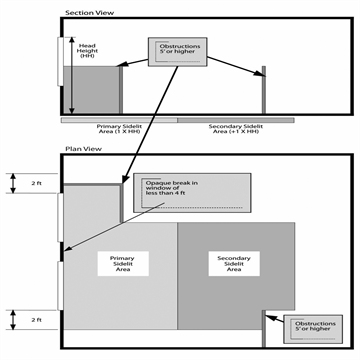 |
Figure C405.2.5.2(2)
Sidelit Daylight Zone Adjacent to Clerestory Fenestration in a Wall
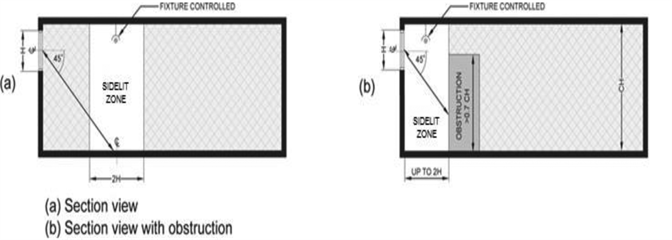 |
Figure C405.2.5.2(3)
Sidelit Daylight Zone Under a Sloped Rooftop Monitor
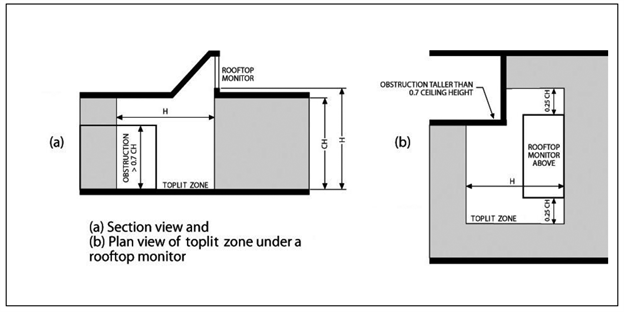 |
C405.2.5.3 Toplit daylight zone. The toplit daylight zone is the floor area underneath a roof fenestration assembly which complies with the following:
1. The toplit daylight zone shall extend laterally and longitudinally beyond the edge of the roof fenestration assembly to the nearest obstruction that is taller than 0.7 times the ceiling height, or up to 0.7 times the ceiling height, whichever is less, as indicated in Figure C405.2.5.3(1).
2. Where toplit daylight zones overlap with sidelit daylight zones, lights within the overlapping area shall be assigned to the toplit daylight zone.
3. The product of the visible transmittance of the roof fenestration assembly and the area of the rough opening of the roof fenestration assembly, divided by the area of the toplit daylight zone is no less than 0.008.
4. Where located under atrium fenestration, the toplit daylight zone shall include the bottom floor area directly beneath the atrium fenestration, and the top floor directly under the atrium fenestration, as indicated in Figure C405.2.5.3(4). The toplit daylight zone area at the top floor is calculated the same as for a toplit daylight zone. Intermediate levels below the top floor that are not directly beneath the atrium are not included.
Figure C405.2.5.3(1)
Toplit Daylight Zone Under a Rooftop Fenestration Assembly
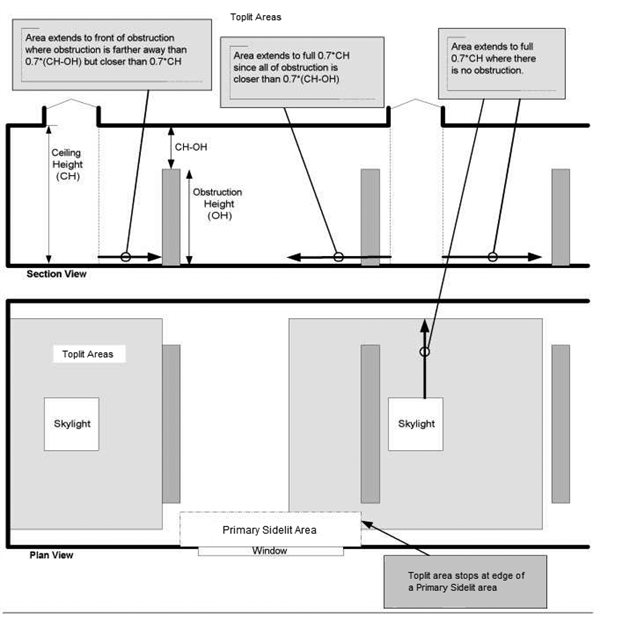 |
Figure C405.2.5.3(2)
Toplit Daylight Zone Under a Rooftop Monitor
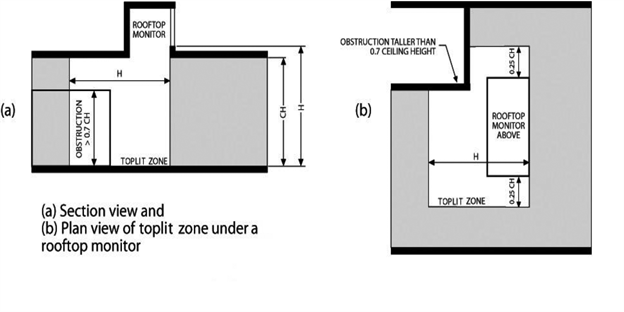 |
Figure C405.2.5.4
Toplit Daylight Zone Under Atrium Fenestration
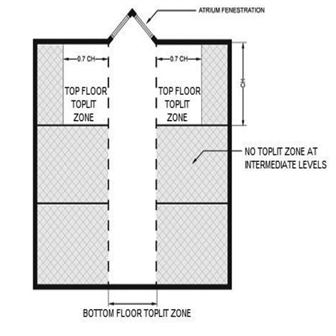 |
C405.2.5.4 Atriums. Daylight zones at atrium spaces shall be established at the top floor surrounding the atrium and at the floor of the atrium space, and not on intermediate floors, as indicated in Figure C405.2.5.4.
[Statutory Authority: RCW 19.27A.045 and chapter 19.27A RCW. WSR 24-16-145, § 51-11C-405025, filed 8/7/24, effective 9/7/24. Statutory Authority: RCW 19.27A.020, 19.27A.025, 19.27A.160 and chapters 19.27A and 19.27 RCW. WSR 22-14-091, 23-12-101, and 23-20-021, § 51-11C-405025, filed 7/1/22, 6/7/23, and 9/25/23, effective 3/15/24. Statutory Authority: RCW 19.27A.025, 19.27A.045 and chapter 19.27 RCW. WSR 20-21-080, § 51-11C-405025, filed 10/19/20, effective 2/1/21. Statutory Authority: RCW 19.27A.020, 19.27A.025, 19.27A.160 and chapter 19.27 RCW. WSR 19-24-040, § 51-11C-405025, filed 11/26/19, effective 7/1/20. Statutory Authority: RCW 19.27A.025, 19.27A.160, and 19.27.074. WSR 16-03-072, § 51-11C-405025, filed 1/19/16, effective 7/1/16. Statutory Authority: RCW 19.27A.020, 19.27A.025 and chapters 19.27 and 34.05 RCW. WSR 13-04-056, § 51-11C-405025, filed 2/1/13, effective 7/1/13.]